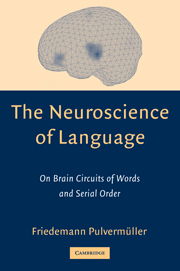Book contents
- Frontmatter
- Contents
- Preface
- The Neuroscience of Language
- 1 A Guide to the Book
- 2 Neuronal Structure and Function
- 3 From Classic Aphasia Research to Modern Neuroimaging
- 4 Words in the Brain
- Excursus E1 Explaining Neuropsychological Double Dissociations
- 5 Regulation, Overlap, and Web Tails
- 6 Neural Algorithms and Neural Networks
- 7 Basic Syntax
- 8 Synfire Chains as the Basis of Serial Order in the Brain
- 9 Sequence Detectors
- 10 Neuronal Grammar
- 11 Neuronal Grammar and Algorithms
- Excursus E2 Basic Bits of Neuronal Grammar
- Excursus E3 A Web Response to a Sentence
- 12 Refining Neuronal Grammar
- Excursus E4 Multiple Reverberation for Resolving Lexical Ambiguity
- Excursus E5 Multiple Reverberations and Multiple Center Embeddings
- 13 Neurophysiology of Syntax
- 14 Linguistics and the Brain
- References
- Abbreviations
- Author Index
- Subject Index
9 - Sequence Detectors
Published online by Cambridge University Press: 15 December 2009
- Frontmatter
- Contents
- Preface
- The Neuroscience of Language
- 1 A Guide to the Book
- 2 Neuronal Structure and Function
- 3 From Classic Aphasia Research to Modern Neuroimaging
- 4 Words in the Brain
- Excursus E1 Explaining Neuropsychological Double Dissociations
- 5 Regulation, Overlap, and Web Tails
- 6 Neural Algorithms and Neural Networks
- 7 Basic Syntax
- 8 Synfire Chains as the Basis of Serial Order in the Brain
- 9 Sequence Detectors
- 10 Neuronal Grammar
- 11 Neuronal Grammar and Algorithms
- Excursus E2 Basic Bits of Neuronal Grammar
- Excursus E3 A Web Response to a Sentence
- 12 Refining Neuronal Grammar
- Excursus E4 Multiple Reverberation for Resolving Lexical Ambiguity
- Excursus E5 Multiple Reverberations and Multiple Center Embeddings
- 13 Neurophysiology of Syntax
- 14 Linguistics and the Brain
- References
- Abbreviations
- Author Index
- Subject Index
Summary
The synfire model discussed in Chapter 8 is one example of a realistic model of serial order in the brain. One may call it realistic because it has strong footings in neuroscientific research. Which alternative mechanisms for establishing serial order exist in the nervous system? This chapter reviews a class of serial-order mechanisms different from the synfire chain. It is argued that this type of mechanism may be important for organizing grammar in the brain, and an attempt is undertaken to apply the mechanism to the processing of a simple sentence.
Movement Detection
As emphasized in Chapter 8, the synfire model realizes a sequence of elementary events “A then B” by direct connections between their neuronal representations, α and α. As an alternative, it is possible to connect a third element to both representations of elementary events. The third element, γ, would become active if sequence AB occurs. The third element would be a mediator serving the sequence detection process, which could otherwise be performed by a synfire mechanism as well.
The basic idea for this mechanism of mediated sequence processing has been formulated by McCulloch and Pitts (Kleene, 1956; McCulloch & Pitts, 1943). In Chapter 6, the cardinal cells responding specifically to strings of events were called string detectors. In modern neuroscientific research, several lines of research have proved similar mechanisms in the nervous system of animals.
Many animals respond specifically to stimuli that move. Therefore, they must be equipped with a mechanism for movement detection.
Information
- Type
- Chapter
- Information
- The Neuroscience of LanguageOn Brain Circuits of Words and Serial Order, pp. 159 - 167Publisher: Cambridge University PressPrint publication year: 2003
